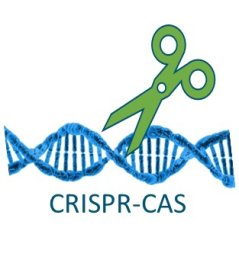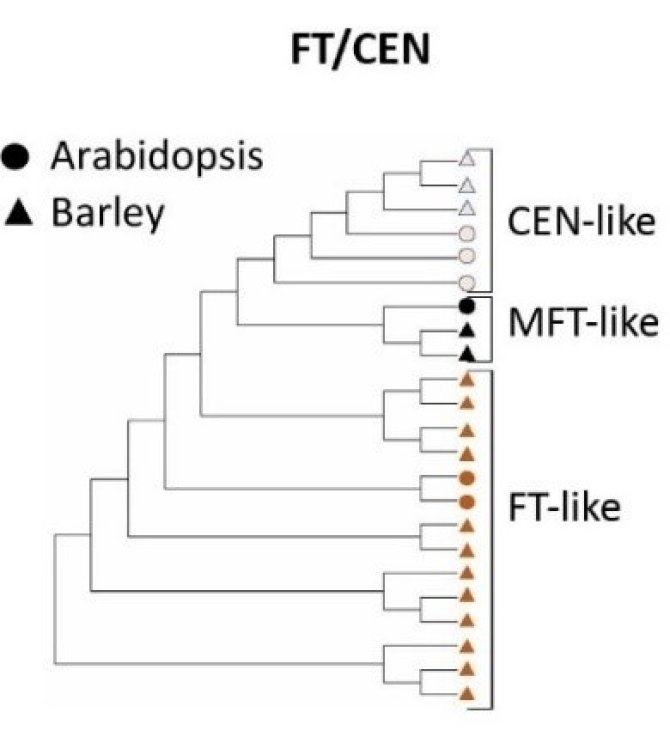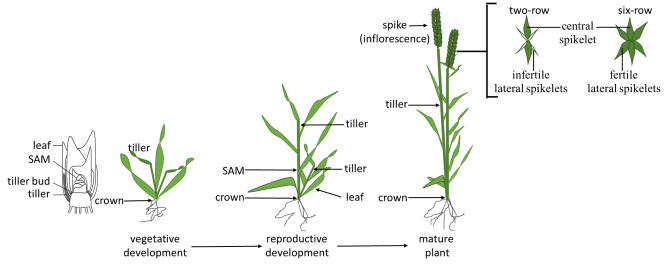
Plant architecture and development (Van Esse Group)
My group’s research focuses on understanding the genetic and molecular networks that are control different yield related traits such as developmental timing, seed and tiller number. We use natural and induced variation to study the genetic loci that control these key traits and state of the art ~omics tools to place these genes in precise molecular and cellular context.
Our long term goal is to build a solid fundamental understanding of the genes and molecular networks that control plant architecture and development. We make use of sophisticated 'omics'-technologies, including ChIPseq, RNAseq, yeast n-hybrid assays, and CRISPR mutagenesis. We welcome, on regular basis, BSc and MSc students that join our research team and perform their own project affiliated to ongoing research. Students are supervised by enthusiastic and highly motivated PhD students and researchers. Below some examples of the various opportunities for Bsc and Msc students.
Topics:
CRISPR-Cas mutagenesis and cereal development

Targeted mutagenesis is a important part in our research to unravel the role of key regulatory genes in plant development. Within our laboratory, we use on routine basis CRISPR-Cas mutagenesis approaches in various plant species. Within this team, we mainly focus on CRISPR-Cas in barley.
Typical student projects involve construct design, using Golden Gate cloning, for targeted mutagenesis. Depending on the length of the thesis and project availability, you will also gain experience with plant transformation to perform genome editing and analyse the mutations/deletions created.
Interested gaining experience with CRISPR during your BSc or MSc thesis project? Please feel free to contact us to discuss the various opportunities.
Protein-Protein and Protein-DNA interaction studies
On regular basis, we perform protein-protein and protein-DNA interaction studies in our team using yeast-n-hybrid assays, but also other complementary techniques such as Co-immunoprecipitations. Typical questions raised are for example, what protein-protein interaction does a key regulator have? Or where does this regulator bind to the DNA?
Interested in protein-protein or protein-DNA interactions? Please feel free to contact us to discuss opportunities within the ongoing projects.

Bioinformatics
Within our team, we have on regular basis bioinformatic data sets to be analysed. This can range from Transcriptional profiling (RNA-Seq) to natural variation studies, phylogenetics, variant-calling, and detailed protein-domain analysis.
Interested in doing a bioinformatics BSc or MSc thesis project? Please contact us to discuss the various opportunities.
Understanding the role of gene duplications in cereals- CRISPR
FLOWERING LOCUS-T (FT) is a key flowering time activator that acts antagonistically to CENTRORADIALIS (CEN), which acts as a inhibitor of flowering. Both FT and CEN are crucial determinants of flowering time.
FT/CEN-like gene family members are characterized by extensive gene duplication events that occurred independently in nearly all flowering plants, which has led to diversification in the roles of these genes resulting in sub-and neofunctionalization: In potato FT-like genes are important regulators of tuberization; and in wheat TaFT2 influences spikelet development and floret fertility, while this gene only shows minor effects on flowering time. The FT/CEN gene family exemplifies that based on sequence similarity alone, it is thus hard to understand the function of a gene crop species, especially when gene duplications have arisen.

Within this thesis project the student will focus on understanding the role of gene duplications and the impact on barley plant architecture and development.
Typical student gains experience with:
- CRISPR in barley, including construct design
- Tissue culture
- Golden Gate cloning
- PCR, genotyping
- Project/time management, writing and presenting your thesis
Interested? Contact PhD student:
Unravelling genetic networks that control tiller and spike development in barley
Cereals such as barley and wheat are important crop species for food and feed supply. Cereal crop yield depends on traits such as the number of seeds per spike, the number side shoots (tillers) and the seed weight. These traits are often negatively correlated which makes improvement of yield difficult. Recent evidence indicates that the same genes affect both seed and tiller number. Optimizing yield by changing these traits is possible, but will require an in-depth and fundamental understanding of the molecular mechanisms that affect both inflorescence and shoot branching. The regulation of branching has been well studied in model systems like Arabidopsis and rice. In comparison, little is known about the regulation of branching in temperate cereals such as barley and its close relative wheat.
Within this project, we will study the molecular bases of tiller and/or inflorescence (spike) development in barley.

Typical student gains experience with:
- Y2H screen Protein-protein interactions
- Phylogenetic analysis
- Conserved domain analysis using natural allelic variation
- Transfer knowledge obtained in barley to other crops
- Selection CRISPR-CAS9 mutagenized plants in barley
- Project management, writing and presenting your thesis
Cereal root development: What happens below ground?
Within this project, which is a collaboration between the van Esse and Willemsen group we are unravelling the impact of PLETHORA gene family members on cereal root development. For this, we use a scale of different techniques, but also CRISPR mutagenesis and generation of marker lines for detailed phenotyping.
Typical student gains experience with one or more of the following topics:
- CRISPR in barley
- Plant transformation
- Construct design, golden gate and/or gateway cloning
- PCR, genotyping
- Root phenotyping
- Project management, writing and presenting your thesis